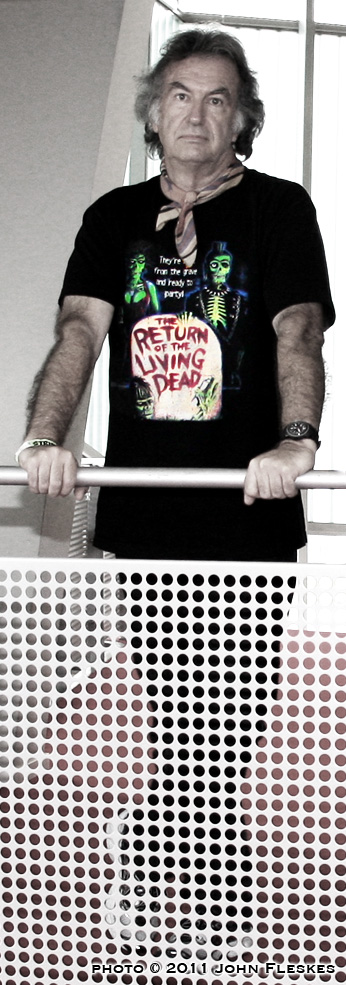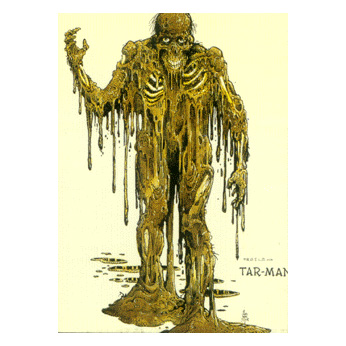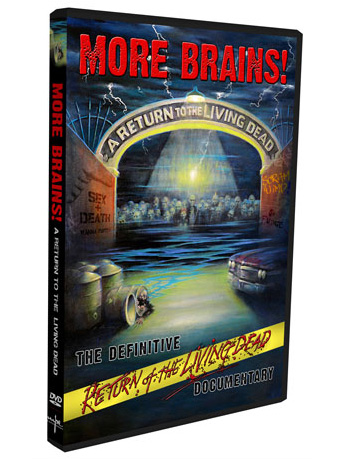
Since its release in 1985, The Return of the Living Dead’s cult status among zombie filmgoers and inspiration upon subsequent zombie movies has continued to grow at a sharp rate. 2011 has proven that people can’t get enough of the film. A handful of sold out appearances of the entire cast and crew at horror shows and film events, the success of the book, “The Complete History of The Return of the Living Dead” that was released in early 2011, and with rave reviews for the new documentary, “More Brains! The Definitive Return to the Living Dead Documentary,” have all proven this film is not about to fade into the past anytime soon.
I took the opportunity to contact William Stout, who was the production designer of the film, to ask him some questions about his contributions to the film, and how he feels about the recognition he is receiving for work he did over 25 years ago. Stout opens up in the following interview to give us his insight into the film and even a new never before told story.
Flesk: You were the production designer for The Return of the Living Dead. Can you give me some insight into what a production designer does?
William Stout: The production designer functions as the eyes of the director. He is responsible for everything you see on the screen except for the performances of the actors. As production designer I oversee all of the set designs, creature designs, special effects, props, costumes, set decoration, storyboards, make-up and special make-up effects. I usually have about 1200 people working under my supervision.

Flesk: What type of role did you play on the film?
Stout: I directly designed most of the sets, the special effects shots, a lot of the set decoration and all of the zombies. I storyboarded several crucial scenes as well.
I’m a very hands-on production designer. I was under the gurney of the Half Corpse, for example, making her spinal cord flop around and ooze spinal fluid. I was on set every day of the shoot, which was easy when we were shooting interiors. I just had to step out of my office to be on set!
It was my idea to have a butterfly collection come alive at a crucial point in the film. I built it, cutting paper butterflies from butterfly books, then pinning them to a collection board. When it was time to shoot it, I was the guy behind the camera waving a clipboard at them to make their wings appear as if they were fluttering.
I have a cameo in the film as the alcoholic bum the punks step over in the beginning of the movie. I designed my own make-up and wardrobe! I was originally cast by the director to be the shopping cart bum who gets bitten by Trash (Linnea Quigley) but our producer nixed the idea. He figured (quite rightly so, I believe) that I had enough on my plate as production designer. I sculpted Trash’s face for that scene. I rarely sculpt — there are other people who are better and faster than I am — but Dan O’Bannon, the director, insisted.
Flesk: Did you ever expect for The Return of the Living Dead to become a cult favorite and receive the type on ongoing attention that seems to continually grow?
Stout: Not at all! I don’t care who you are in the Film Biz; no one knows if they’ve got a hit or a miss until they have that first screening with a real movie audience — and even then they might not know! It amazes me that The Return of the Living Dead is more popular now than when it was first released and that its popularity shows no signs of letting up. It’s the best movie ever made for a lot of people. That blows my mind, as I think everyone should realize that the 1933 King Kong is the best movie ever!
Flesk: What do you think it is about The Return of the Living Dead when compared to the many other horror and zombie films that have come out that makes this one stand out as such a cult favorite?
Stout: 1) It’s really scary. 2) It’s really funny. Very few films have ever pulled that off. The only other ones that immediately spring to mind are Abbott and Costello Meet Frankenstein, a real favorite of mine, plus that great opening to An American Werewolf in London. Both films play the horror aspects very seriously, which creates a nervous tension that makes the funny stuff even funnier.
Flesk: How rewarding is it for you to have the recent group events with the entire cast of The Return of the Living Dead?
Stout: It’s a total blast! I’ve worked on over forty feature films, yet TROTLD is the only one out of all those films where I have stayed really close to the cast. We’re all such good buds; we love being with each other. To use a show biz cliché, we truly are like family.
Director Dan O’Bannon gave us a tremendous gift when he fought for — and got — two weeks of rehearsal prior to shooting. Since the film hadn’t been totally cast, I stood in for some of the roles during rehearsal. During those two weeks the cast and I all bonded as friends. I think it made the performances much more believable in the movie. These characters really feel like they have a past together.
Flesk: There was a recent book about the making of The Return of the Living Dead and now the new More Brains! documentary. Do you feel they both captured the process well and the stories behind the film?
Stout: Both the book and the DVD are terrific; everyone really did their homework. While not every great story regarding the making of TROTLD was told, between the book and the DVD, most of them were. Making that movie was a wild experience from start to finish, mostly thanks to Dan O’Bannon.
Flesk: When you were hired as the production designer I believe you were the youngest in film history to assume that role. Were you intimidated by the position and responsibility?
Stout: Yes and no.
Yes, because despite having already worked as a designer on several major films (Conan the Barbarian, Raiders of the Lost Ark, First Blood, Conan the Destroyer, Clan of the Cave Bear), I was always working under a top production designer. I paid attention on those films and learned as much as I could. TROTLD, though, was the first movie in which I was the guy who would be completely responsible for what ended up on the screen.
No, because I was young and pretty cocky. I thought I could do anything! I had also spent the two years previous to TROTLD as the production designer on an American Godzilla movie that, unfortunately, never got made. I gained tremendous confidence working on that film. On Godzilla I got to hire the cream of the Movie Biz’s top talent: guys like Rick Baker, Dave Allen, Dave Stevens, Doug Wildey and Stephen Czerkas, for example.
Flesk: How did you approach such a massive undertaking?
Stout: Fortunately, TROTLD’s line producer sensed how green I was. He assigned me Robert Howland as my art director. Robert was such a great, seasoned pro; he saved my designer butt on a number of occasions. I used Robbie again as my art director on Masters of the Universe. I miss him and his great sense of humor enormously. He died from AIDS after Masters.
Flesk: Were you ever concerned that the film would be considered campy due to the comedy infused in the film? Did you feel like you were creating a serious work at the time?
Stout: We took our little film — and its comedy — very seriously. Dan pushed the actors to go a bit broader than I would have but he knew exactly what he was doing. I don’t really consider TROTLD to be “camp” and, actually, I don’t think I’ve ever heard it referred to as being camp. Funny, yes; irreverent, yes; imaginative, yes; outrageous, yes; scary, yes. But camp? No. I think it’s just damn good. It accomplishes what it set out to do.
Flesk: Do you have a memorable story from working on the film that you can share?
Stout: Let me see if I can think of a TROTLD story I’ve never told before…
Because of the nature of the film, it could be pretty creepy on set. We were shooting at the downtown Los Angeles location of the Uneeda Medical Supply warehouse (actually a downtown loft apartment). It was beginning to get dark. While waiting for the lights to be set up, I began poking around our location. Amidst a small pile of rubble, I spotted an anomaly. It looked like there was some blond hair slightly sticking out from the top of a cardboard box. Upon closer inspection, it looked like the beautiful blond hair of a woman. I feared I might have just discovered a decapitated and clumsily discarded severed head. This was downtown L. A., after all, so it was in the distinct realm of possibility.
I sought out the police officer we had employed on set and brought him over to the box. He approached it very cautiously, drawing his weapon. With the barrel of his gun he nudged open the cardboard flaps of the box.
Inside was a very blond, very dead…longhaired cat.
Oh, the things one imagines when making a horror movie!
Flesk: Thanks for your time, Bill!
Enjoy,
John
John Fleskes
Flesk Publications
Interview copyright © 2011 John Fleskes and William Stout
William Stout photograph © 2011 John Fleskes
William Stout Tar-Man artwork © William Stout
Links:
The Complete History of The Return of the Living Dead book
More Brains! The Definitive Return to the Living Dead documentary
William Stout website
William Stout books at Flesk Publications


Loved the interview and hearing Bill speak about his passion. Thanks for doing such a great job.
Thanks, Karen! I’m glad to hear you enjoyed the interview.
–John
Somehow I get the feeling that Bill has an aversion to campy. I happen to love it when used the right way. So if campy is attached to Return then only in the best and most respectful way. Thanks for this John.
An astute observation. Well said, Bill. — John